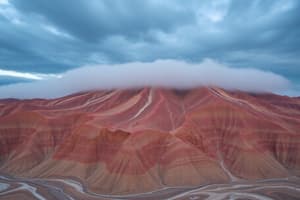Podcast
Questions and Answers
What is the composition of the Earth's atmosphere?
What is the composition of the Earth's atmosphere?
78% Nitrogen, 21% Oxygen, and 1% other gases (Argon, Carbon Dioxide, Water Vapor)
What did Earth's early atmosphere lack?
What did Earth's early atmosphere lack?
Oxygen
What was the first oxygen-producing bacteria?
What was the first oxygen-producing bacteria?
Cyanobacteria
What layers is Earth's atmosphere made of?
What layers is Earth's atmosphere made of?
What is the troposphere?
What is the troposphere?
What is the stratosphere?
What is the stratosphere?
What is the mesosphere?
What is the mesosphere?
What is the thermosphere?
What is the thermosphere?
What is the exosphere?
What is the exosphere?
What is radiation?
What is radiation?
What is conduction?
What is conduction?
What is convection?
What is convection?
What are Global Winds?
What are Global Winds?
What are the atmospheric layers divided by?
What are the atmospheric layers divided by?
What are pauses?
What are pauses?
Flashcards are hidden until you start studying
Study Notes
Composition of Earth's Atmosphere
- Current atmospheric composition: 78% Nitrogen, 21% Oxygen, 1% other gases (Argon, Carbon Dioxide, Water Vapor).
- Early atmosphere was drastically different and primarily created by volcanic outgassing.
Early Atmosphere Characteristics
- Early atmosphere lacked atmospheric Oxygen.
- Absence of rust in iron fossil evidence indicates negligible oxygen prior to 2.3 billion years ago.
Oxygen-Producing Lifeforms
- Cyanobacteria were the first known oxygen-producing bacteria.
- Fossils date back several hundred million years before oxygen abundance created red beds.
Layers of Earth's Atmosphere
- Composed of five main layers: Troposphere, Stratosphere, Mesosphere, Thermosphere, Exosphere.
Troposphere
- The lowest atmospheric layer extending from the ground to 7.5 miles up.
- Contains 75-80% of atmospheric gases and is where most weather occurs.
- Atmospheric pressure decreases with elevation; at sea level, pressure is about 14 pounds per square inch.
Stratosphere
- Lies above the Troposphere, from approximately 7.5 to 25 miles above the ground.
- Houses the Jet Stream, which consists of high-speed wind belts influencing weather patterns in lower states.
- Contains the ozone layer, which protects life from harmful UV radiation; degraded by CFCs (mostly banned).
Mesosphere
- Middle layer of the atmosphere, approximately 25 to 55 miles in altitude.
- Site where meteors begin to burn upon entering the atmosphere.
Thermosphere
- Uppermost layer, ranging from about 55 miles to over 300 miles.
- Characterized by extremely high temperatures due to solar radiation interacting with atmospheric gases.
- Contains the Ionosphere, where charged particles exist; also the location of Aurora Borealis phenomena.
Exosphere
- The outermost layer of Earth's atmosphere leading into outer space.
Types of Heat Transfer
- Radiation: Movement of energy through wave motion.
- Conduction: Energy transfer through direct touch.
- Convection: Circular movement of heat in fluids.
Global Winds
- Wind belts function as massive convection currents, redistributing heat and weather patterns globally.
- Prevailing Westerlies primarily influence weather in the lower 48 states, including Virginia.
Division of Atmospheric Layers
- Layers are categorized based on thermal properties, chemical composition, movement, and density.
Atmospheric Boundaries
- "Pauses" denote boundaries where significant changes occur, marked by shifts in temperature, chemical makeup, or density.
Studying That Suits You
Use AI to generate personalized quizzes and flashcards to suit your learning preferences.




